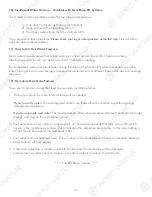
31
Step 3.
Re-attach the filter housing to the RO head. Hand tighten the housing, then use the filter
housing wrench and simply give an additional quarter inch turn.
Do Not
over tighten the
housing.
Step 4.
Open the tank ball valve and feed water line. Check for leaks. If the filter housing continues to
leak, please contact APEC technician for replacement assistance.
- Forgot to insert membrane into its housing
—>
Put membrane into housing.
- Membrane is inserted incorrectly
—>
Re-insert membrane correctly. See
Fig.15B
(Page 20)
.
- Water pressure too low, causing TDS to be higher than usual
—>
Raise water pressure or add
pump to RO.
- Input source water has very high TDS and/or contains certain heavy dissolved elements resulting in
TDS higher than usual.
- Drain water flow is restricted or clogged
—>
Check and re-align the drain saddle and drain line.
- Your input water’s TDS fluctuates resulting in high “composite” TDS in the holding tank
—>
To
verify this, test the filtered water’s TDS before it enters the tank. Do test as follows:
Test #1 TDS from tank:
Dispense some water from the RO faucet, this water comes directly from the tank.
Test TDS, record the reading, then Do Test #2.
Test #2 TDS bypassing tank:
Turn OFF tank valve. Disconnect the Yellow line from the tank’s valve. A
stream of filtered water will trickle out of the Yellow line. Let the water trickle freely for about 1 minute,
then Catch some water here and do a TDS test. The TDS here is the actual
“real time TDS”
the RO is
producing before water enters the tank. Compare this TDS reading with the tank’s TDS you get in Test
#1.
If tank TDS is higher than Yellow line TDS, that means your source water’s TDS level fluctuates over time.
So, from day to day, the TDS highs and lows accumulate in the tank resulting in a high “composite TDS”
reading. This is especially true if you’re on a private well. The well pump’s fluctuating pressure cycles
also cause TDS to go up and down. In this case, the
“real-time”
TDS from the Yellow line (prior to the
tank) is the system’s true performance. If this number is within 10% of your tap TDS, then it is within an
acceptable range, and your RO system is working fine.
Drawing more water can help stabilize the TDS. If you are only drawing a small amount of water every
time, the unit will quickly turn On and Off, not allowing the membrane to receive full inlet pressure,
causing a spike in the TDS.
6) TDS (Total Dissolved Solids) Level Reads Higher Than Normal
How to test TDS correctly:
See
“TDS Meter -- How to Test Your Water Quality”
instructions on page
25.
If the filtered water’s TDS reads higher than the normal 10% range, these are the possible causes:











































